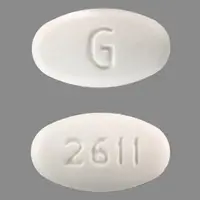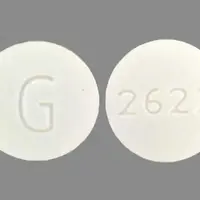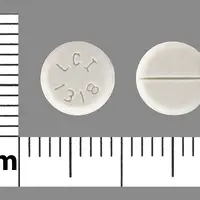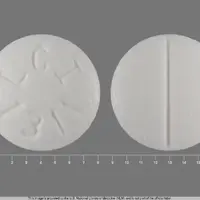Generic name: medically reviewed
Availability: Prescription only
Pregnancy & Lactation: Risk data available
Brand names: Terbutaline (oral/injection)
What is Terbutaline (monograph)?
Warning
Special Alerts:
A standardized concentration for this drug has been established through Standardize 4 Safety (S4S), a national patient safety initiative to reduce medication errors, especially during transitions of care. The drug is included in a standard concentration list which may apply to an IV or oral compounded liquid formulation. For additional information, see the ASHP website [Web].
Warning
- Preterm Labor
-
Injection is not FDA labeled for and is contraindicated for prolonged tocolysis (beyond 48–72 hours). Oral tablets are not FDA labeled for and are contraindicated for acute or maintenance tocolysis. Do not use terbutaline sulfate (injection or oral tablets) for maintenance tocolysis, particularly in the outpatient or home setting. (See Preterm Labor under Cautions and Preterm Labor under Uses.)
-
Serious, sometimes fatal adverse effects, including increased heart rate, transient hyperglycemia, hypokalemia, cardiac arrhythmias, pulmonary edema, and myocardial ischemia, reported after administration in pregnant women. Increased fetal heart rate and neonatal hypoglycemia may occur as a result of maternal administration. (See Preterm Labor under Cautions.)
Introduction
Bronchodilator; relatively selective, short-acting β2-adrenergic agonist.
Uses for Terbutaline
Bronchospasm in Asthma
Symptomatic management or prevention of bronchospasm in patients with reversible, obstructive airway disease (e.g., asthma).
Some experts suggest use of oral β2-adrenergic agonist therapy principally in patients unable to use inhaled bronchodilators (e.g., young children). Other experts do not recommend oral β2-agonists for relief of acute asthma symptoms. Oral administration associated with slower onset of action and increased incidence of adverse effects.
Sub-Q terbutaline reserved for prehospital management of severe asthma exacerbations when inhaled β2-selective agents are not readily available. Sub-Q terbutaline not used routinely for treatment of severe exacerbations of asthma in hospitalized patients. No proven advantage of sub-Q administration compared with oral inhalation (no longer commercially available in US).
Bronchospasm in COPD
Symptomatic management of reversible bronchospasm associated with chronic bronchitis and emphysema.
Inhaled β2-adrenergic agonists preferred over oral β2-adrenergic agonist therapy for treatment of COPD; long-acting inhaled bronchodilators more effective and convenient than short-acting agents. Oral β2-adrenergic agonist use associated with slower onset of action and increased incidence of adverse effects compared with inhaled therapy.
Role of oral β2-adrenergic agonists in treatment of COPD limited.
Preterm Labor
Has been used for acute IV† [off-label] or sub-Q therapy in selected women to inhibit uterine contractions in preterm labor† [off-label] (tocolysis) and prolong gestation when beneficial.
Manufacturers and FDA warn that injection is not FDA labeled for and is contraindicated for prolonged tocolysis (beyond 48–72 hours), because of the potential for serious maternal cardiac effects and death. (See Preterm Labor under Cautions.)
Manufacturers and FDA also warn that oral tablets are not FDA labeled for and are contraindicated for acute or maintenance tocolysis, because efficacy not proven and safety concerns similar to injection. (See Preterm Labor under Cautions.)
Do not use terbutaline sulfate (injection or oral tablets) for maintenance tocolysis, particularly in the outpatient or home setting. (See Preterm Labor under Cautions.)
However, available data suggest that acute β-adrenergic agonist treatment may forestall labor for 48 hours, providing time for patients to be transferred to other (e.g., tertiary-care) facilities and/or receive corticosteroids to increase fetal lung maturation. Any other potential benefits of such drugs in prolonging pregnancy are unclear.
ACOG states that because of conflicting results, there is no clear first-line tocolytic agent.
Related/similar drugs
Xolair, albuterol, dexamethasone, hydrocortisone, Symbicort, Dupixent, Breo ElliptaTerbutaline Dosage and Administration
Administration
Administer orally or sub-Q.
Has been administered IV† [off-label] to inhibit uterine contractions in preterm labor† [off-label] (tocolysis). Administration of sub-Q injection preparation by other routes (e.g., IV) or methods not recommended by manufacturer. (See Preterm Labor under Cautions.)
Oral Administration
Administer orally 3 times daily during waking hours, at approximately 6-hour intervals.
Sub-Q Administration
For solution and drug compatibility information, see Compatibility under Stability.
Inject into lateral deltoid area.
Dosage
Available as terbutaline sulfate; dosage expressed in terms of sulfate salt.
Pediatric Patients
Bronchospasm
Asthma
OralChildren or adolescents 12–15 years of age: 2.5 mg 3 times daily. Do not exceed total dosage of 7.5 mg within a 24-hour period.
Sub-QHospitalized children ≤12 years of age† [off-label] with acute asthma exacerbation: 0.01 mg/kg has been given every 20 minutes for a total of 3 doses, then every 2–6 hours as needed.
Children or adolescents ≥12 years of age: 0.25 mg recommended by manufacturer. Repeat dose (0.25 mg) if substantial clinical improvement does not occur within 15–30 minutes. If no response within another 15–30 minutes, consider other therapeutic measures. Manufacturer states total dosage should not exceed 0.5 mg within a 4-hour period.
Hospitalized children or adolescents >12 years of age with asthma exacerbation: 0.25 mg every 20 minutes for a total of 3 doses suggested by some clinicians.
Adults
Bronchospasm
Asthma
Oral5 mg 3 times daily, given approximately every 6 hours during waking hours. If disturbing adverse effects occur, reduce dosage to 2.5 mg 3 times daily. Do not exceed total dosage of 15 mg within a 24-hour period.
Sub-Q0.25 mg recommended by manufacturer. Repeat dose (0.25 mg) if substantial clinical improvement does not occur within 15–30 minutes. If no response within another 15–30 minutes, consider other therapeutic measures. Manufacturer states total dosage should not exceed 0.5 mg within a 4-hour period.
Hospitalized adults with asthma exacerbation: 0.25 mg every 20 minutes for a total of 3 doses suggested by some clinicians.
COPD
Oral5 mg 3 times daily, given approximately every 6 hours during waking hours. If disturbing adverse effects occur, reduce dosage to 2.5 mg 3 times daily. Do not exceed total dosage of 15 mg within a 24-hour period.
Sub-Q0.25 mg recommended by manufacturer. Repeat dose (0.25 mg) if substantial clinical improvement does not occur within 15–30 minutes. If no response within another 15–30 minutes, consider other therapeutic measures. Manufacturer states total dosage should not exceed 0.5 mg within a 4-hour period.
Preterm Labor†
IV†
Carefully adjust rate and duration of infusion according to patient’s response as indicated by uterine response, maternal BP, and maternal and fetal heart rates.
For acute tocolytic therapy, has been initiated at a dosage of 2.5–20 mcg/minute. Dosage may be increased gradually as tolerated at 10- to 20-minute intervals until desired effects achieved. Effective maximum dosages have ranged from 17.5–30 mcg/minute, although higher maximum dosages (e.g., 70–80 mcg/minute) used cautiously in some patients.
Injection is contraindicated for prolonged tocolysis (beyond 48–72 hours). (See Preterm Labor under Cautions and Preterm Labor under Uses.)
Sub-Q
0.25 mg every 0.3–3 hours has been recommended.
Temporarily discontinue if pulse rate is >120 bpm.
Injection is contraindicated for prolonged tocolysis† (beyond 48–72 hours). (See Preterm Labor under Cautions and Preterm Labor under Uses.)
Prescribing Limits
Pediatric Patients
Bronchospasm
Asthma
OralChildren 12–15 years of age: Maximum 7.5 mg within a 24-hour period.
Sub-QChildren ≥12 years of age: Maximum: 0.5 mg within a 4-hour period.
Adults
Bronchospasm
Asthma
OralMaximum 15 mg within a 24-hour period.
Sub-QMaximum 0.5 mg within a 4-hour period.
COPD
OralMaximum 15 mg within a 24-hour period.
Sub-QMaximum 0.5 mg within a 4-hour period.
Preterm Labor†
IV†Effective maximum dosages have ranged from 17.5–30 mcg/minute; higher maximum dosages (e.g., 70–80 mcg/minute) used cautiously in some patients.
Injection is contraindicated for prolonged tocolysis (beyond 48–72 hours). (See Preterm Labor under Cautions and Preterm Labor under Uses.)
Sub-QInjection is contraindicated for prolonged tocolysis (beyond 48–72 hours). (See Preterm Labor under Cautions and Preterm Labor under Uses.)
Special Populations
Geriatric Patients
Select dosage with caution because of age-related decreases in hepatic, renal, and/or cardiac function and potential for concomitant disease and drug therapy.
Warnings
Contraindications
-
Injection: Prolonged tocolysis† (beyond 48–72 hours); do not use for maintenance tocolysis, particularly in the outpatient or home setting. (See Preterm Labor under Cautions and Preterm Labor under Uses.)
-
Oral: Acute or maintenance tocolysis; do not use for maintenance tocolysis†, particularly in the outpatient or home setting. (See Preterm Labor under Cautions and Preterm Labor under Uses.)
-
Known hypersensitivity to sympathomimetic agents or any ingredient in formulation.
Warnings/Precautions
Warnings
Preterm Labor
Serious and sometimes fatal adverse effects, including increased heart rate, transient hyperglycemia, hypokalemia, cardiac arrhythmias, pulmonary edema, and myocardial ischemia, reported after administration in pregnant women. Increased fetal heart rate and neonatal hypoglycemia also may occur following maternal administration.
FDA has received postmarketing reports of maternal death and serious cardiovascular events associated with obstetric use. FDA has concluded that risk of serious adverse events outweighs any potential benefit to pregnant women receiving prolonged tocolysis with terbutaline injection (beyond 48–72 hours) or receiving acute or prolonged tocolysis with oral terbutaline.
Injection is not FDA labeled for and is contraindicated for prolonged tocolysis (beyond 48–72 hours). Oral tablets are not FDA labeled for and are contraindicated for acute or maintenance tocolysis. Do not use terbutaline sulfate (injection or oral tablets) for maintenance tocolysis, particularly in the outpatient or home setting. (See Preterm Labor under Uses.)
Report adverse events involving terbutaline to the FDA MedWatch program.
Acute or Worsening Asthma
Failure to respond to a previously effective dosage of terbutaline may indicate seriously worsening asthma. Reevaluate asthma therapy, giving special consideration to possible need for anti-inflammatory treatment (e.g., corticosteroids). Use of β-adrenergic agents alone not adequate to control mild to severe persistent asthma symptoms.
Cardiovascular Effects
Possible clinically important cardiovascular effects, including changes in BP, heart rate, and ECG (e.g., flattening of the T wave, prolongation of the QTc interval, ST-segment depression).
Cautious use recommended in patients with cardiovascular disorders, including ischemic heart disease, coronary insufficiency, cardiac arrhythmias, and hypertension. May require drug discontinuance.
Nervous System Effects
Possible CNS stimulation (e.g., nervousness, tremor). Seizures reported rarely; did not recur following drug discontinuance.
Cautious use recommended in patients with seizure disorders and those unusually responsive to sympathomimetic amines
Sensitivity Reactions
Immediate hypersensitivity reactions and exacerbations of bronchospasm reported.
General Precautions
Endocrine and Metabolic Effects
Large IV† doses may aggravate preexisting diabetes and ketoacidosis.
Use with caution in patients with diabetes mellitus or hyperthyroidism.
Possible hypokalemia; may increase risk of cardiovascular effects. Hypokalemia usually transient, not requiring supplementation.
Specific Populations
Pregnancy
Category C. Restrict use for relief of bronchospasm during labor to women in whom benefits clearly outweigh risks. (See Preterm Labor under Cautions.)
Lactation
Distributed into milk, but in amounts generally considered insufficient to affect nursing infants. Administer to nursing women only if potential benefits to woman outweigh possible risk to infant.
Pediatric Use
Safety and efficacy not established in children <12 years of age.
Geriatric Use
Insufficient experience in patients ≥65 years of age to determine whether geriatric patients respond differently than younger adults. (See Geriatric Patients under Dosage and Administration.)
Common Adverse Effects
Oral: Nervousness, tremor, headache, somnolence, palpitations, dizziness, tachycardia, nausea.
Sub-Q: Nervousness, drowsiness, tremor, headache, palpitations.
How should I use Terbutaline (monograph)
Administration
Administer orally or sub-Q.
Has been administered IV† [off-label] to inhibit uterine contractions in preterm labor† [off-label] (tocolysis). Administration of sub-Q injection preparation by other routes (e.g., IV) or methods not recommended by manufacturer. (See Preterm Labor under Cautions.)
Oral Administration
Administer orally 3 times daily during waking hours, at approximately 6-hour intervals.
Sub-Q Administration
For solution and drug compatibility information, see Compatibility under Stability.
Inject into lateral deltoid area.
Dosage
Available as terbutaline sulfate; dosage expressed in terms of sulfate salt.
Pediatric Patients
Bronchospasm
Asthma
OralChildren or adolescents 12–15 years of age: 2.5 mg 3 times daily. Do not exceed total dosage of 7.5 mg within a 24-hour period.
Sub-QHospitalized children ≤12 years of age† [off-label] with acute asthma exacerbation: 0.01 mg/kg has been given every 20 minutes for a total of 3 doses, then every 2–6 hours as needed.
Children or adolescents ≥12 years of age: 0.25 mg recommended by manufacturer. Repeat dose (0.25 mg) if substantial clinical improvement does not occur within 15–30 minutes. If no response within another 15–30 minutes, consider other therapeutic measures. Manufacturer states total dosage should not exceed 0.5 mg within a 4-hour period.
Hospitalized children or adolescents >12 years of age with asthma exacerbation: 0.25 mg every 20 minutes for a total of 3 doses suggested by some clinicians.
Adults
Bronchospasm
Asthma
Oral5 mg 3 times daily, given approximately every 6 hours during waking hours. If disturbing adverse effects occur, reduce dosage to 2.5 mg 3 times daily. Do not exceed total dosage of 15 mg within a 24-hour period.
Sub-Q0.25 mg recommended by manufacturer. Repeat dose (0.25 mg) if substantial clinical improvement does not occur within 15–30 minutes. If no response within another 15–30 minutes, consider other therapeutic measures. Manufacturer states total dosage should not exceed 0.5 mg within a 4-hour period.
Hospitalized adults with asthma exacerbation: 0.25 mg every 20 minutes for a total of 3 doses suggested by some clinicians.
COPD
Oral5 mg 3 times daily, given approximately every 6 hours during waking hours. If disturbing adverse effects occur, reduce dosage to 2.5 mg 3 times daily. Do not exceed total dosage of 15 mg within a 24-hour period.
Sub-Q0.25 mg recommended by manufacturer. Repeat dose (0.25 mg) if substantial clinical improvement does not occur within 15–30 minutes. If no response within another 15–30 minutes, consider other therapeutic measures. Manufacturer states total dosage should not exceed 0.5 mg within a 4-hour period.
Preterm Labor†
IV†
Carefully adjust rate and duration of infusion according to patient’s response as indicated by uterine response, maternal BP, and maternal and fetal heart rates.
For acute tocolytic therapy, has been initiated at a dosage of 2.5–20 mcg/minute. Dosage may be increased gradually as tolerated at 10- to 20-minute intervals until desired effects achieved. Effective maximum dosages have ranged from 17.5–30 mcg/minute, although higher maximum dosages (e.g., 70–80 mcg/minute) used cautiously in some patients.
Injection is contraindicated for prolonged tocolysis (beyond 48–72 hours). (See Preterm Labor under Cautions and Preterm Labor under Uses.)
Sub-Q
0.25 mg every 0.3–3 hours has been recommended.
Temporarily discontinue if pulse rate is >120 bpm.
Injection is contraindicated for prolonged tocolysis† (beyond 48–72 hours). (See Preterm Labor under Cautions and Preterm Labor under Uses.)
Prescribing Limits
Pediatric Patients
Bronchospasm
Asthma
OralChildren 12–15 years of age: Maximum 7.5 mg within a 24-hour period.
Sub-QChildren ≥12 years of age: Maximum: 0.5 mg within a 4-hour period.
Adults
Bronchospasm
Asthma
OralMaximum 15 mg within a 24-hour period.
Sub-QMaximum 0.5 mg within a 4-hour period.
COPD
OralMaximum 15 mg within a 24-hour period.
Sub-QMaximum 0.5 mg within a 4-hour period.
Preterm Labor†
IV†Effective maximum dosages have ranged from 17.5–30 mcg/minute; higher maximum dosages (e.g., 70–80 mcg/minute) used cautiously in some patients.
Injection is contraindicated for prolonged tocolysis (beyond 48–72 hours). (See Preterm Labor under Cautions and Preterm Labor under Uses.)
Sub-QInjection is contraindicated for prolonged tocolysis (beyond 48–72 hours). (See Preterm Labor under Cautions and Preterm Labor under Uses.)
Special Populations
Geriatric Patients
Select dosage with caution because of age-related decreases in hepatic, renal, and/or cardiac function and potential for concomitant disease and drug therapy.
What other drugs will affect Terbutaline (monograph)?
Specific Drugs
|
Drug |
Interaction |
Comments |
|---|---|---|
|
Antidepressants, tricyclic |
Potentiation of vascular effects |
Extreme caution recommended with concomitant therapy or in patients receiving terbutaline ≤2 weeks after discontinuance of tricyclic antidepressants |
|
β-Adrenergic blocking agents |
Potential antagonism of pulmonary effects resulting in severe bronchospasm in asthmatic patients |
If concomitant therapy required, consider cautious use of cardioselective β-adrenergic blocking agents without intrinsic sympathomimetic activity (e.g., metoprolol, atenolol, esmolol); use low dosages initially |
|
Diuretics, potassium depleting |
Potential for decreased serum potassium concentrations and/or ECG changes, especially when recommended β-adrenergic agonist dosage exceeded |
Use concomitantly with caution |
|
MAO inhibitors |
Potentiation of vascular effects |
Extreme caution recommended with concomitant therapy or in patients receiving terbutaline ≤2 weeks after discontinuance of MAO inhibitors |
|
Sympathomimetic agents |
Potential for additive adverse cardiovascular effects |
Concomitant use not recommended Does not preclude use of an inhaled adrenergic agonist bronchodilator to relieve acute bronchospasm during long-term oral terbutaline therapy |







